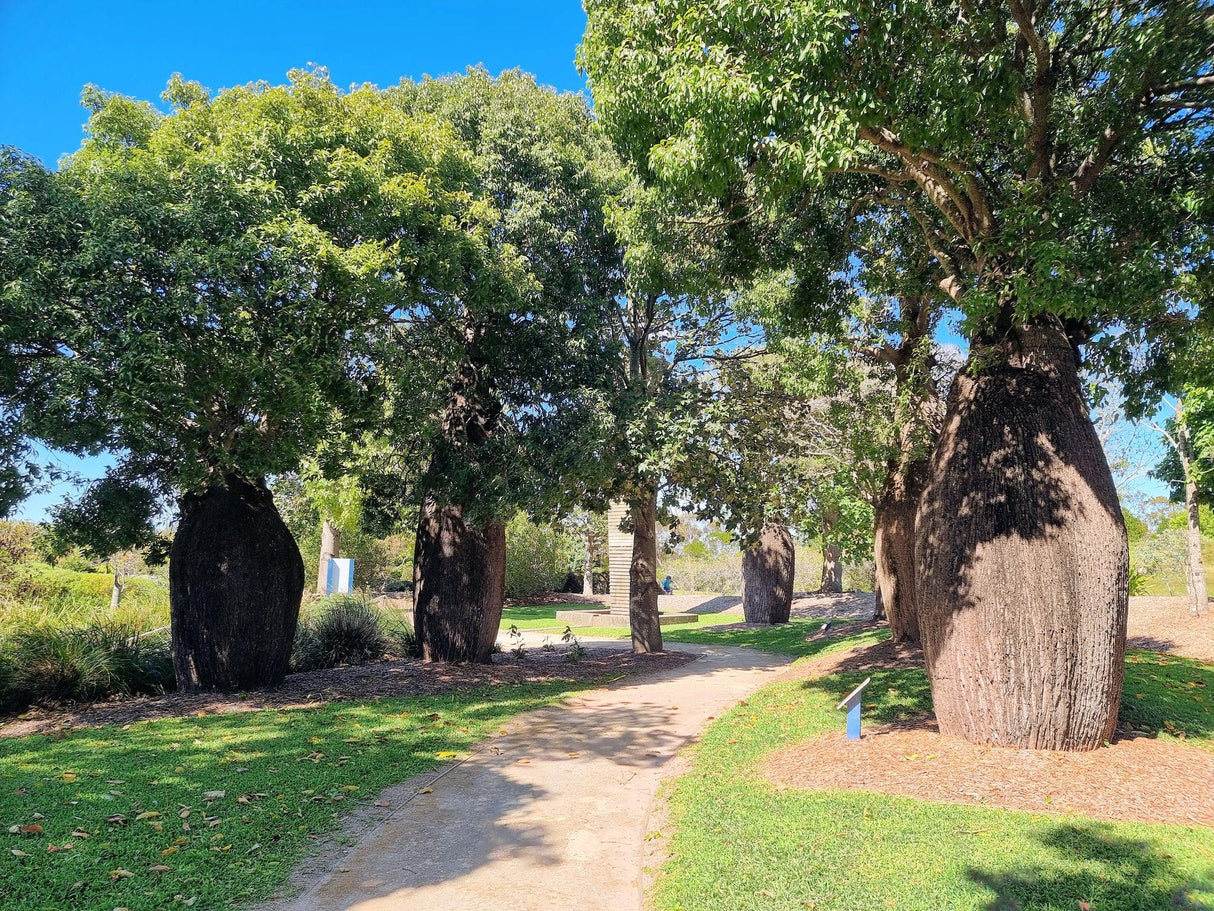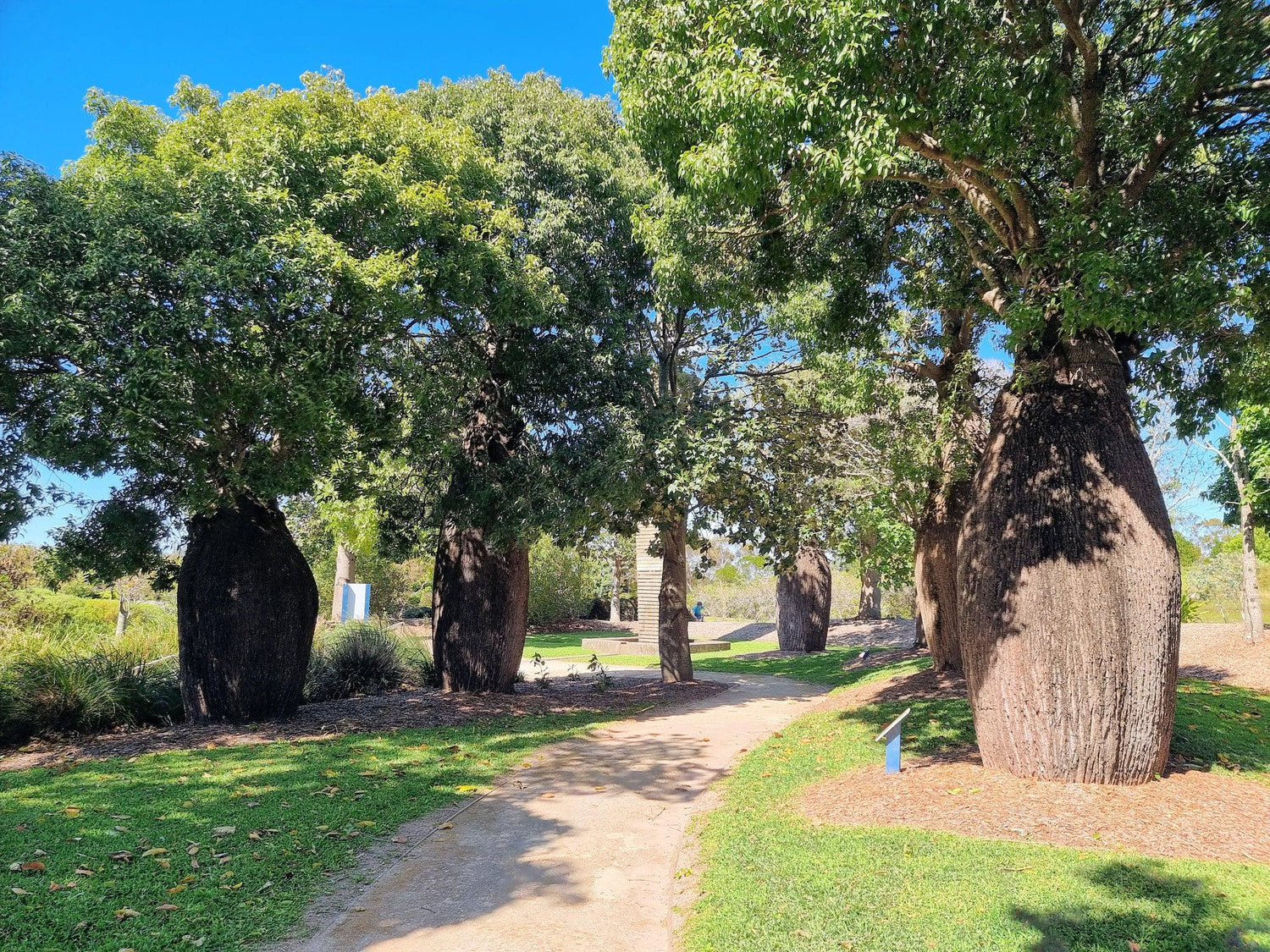Adansonia gregorii
The Adansonia gregorii, or Boab Tree, is a unique and iconic deciduous tree native to northern Australia, known for its swollen trunk, distinctive silhouette, and cultural significance. Growing up to 10–15 meters, it has a broad, bottle-shaped trunk used for water storage and produces large, creamy-white flowers with a sweet fragrance. Its branches form an umbrella-like canopy, providing shade in arid landscapes.
The Boab is well-adapted to dry climates and poor soils, making it a valuable addition to arid gardens, landscapes, and conservation efforts.
Specifications:
- Height: 10–15 meters
- Width: 4–6 meters (trunk diameter can exceed 2 meters)
- Native to: Northern Australia
- Foliage: Palmate leaves that drop during the dry season
- Growth rate: Slow to moderate
Conditions:
- Soil: Prefers well-drained sandy or loamy soils; tolerates poor and rocky soils
- Light: Full sun
- Water: Very low; highly drought-tolerant once established
- Climate: Thrives in arid, semi-arid, and tropical regions
Additional Features:
- Flowers: Large, creamy-white blooms with a sweet fragrance, appearing in late spring to early summer
- Fruit: Hard, woody pods containing edible seeds and pulp
- Uses: Ideal as a feature tree in arid gardens, cultural landscapes, or for conservation planting
- Spacing: Requires ample space due to its trunk size and spreading canopy
- Low Maintenance: Minimal care; prune to shape if necessary
- Cultural Significance: Deeply tied to Indigenous Australian culture as a symbol of survival and a source of food, medicine, and water
- Environmental Benefits: Provides habitat for wildlife, supports soil stability, and stores water
The Boab Tree is a resilient and visually striking tree, offering ecological, cultural, and ornamental value to arid and tropical landscapes.
The Benefits Of Buying An Advanced Tree
The Process Of Transplanting A Mature Tree
Identify the Tree's Root Zone
Identify the Tree's Root Zone
Before you begin, it's essential to identify the root zone or root ball of the tree. This is the area where the majority of the tree's feeder roots are located. It is typically estimated as 1 foot of root ball diameter for each inch of tree trunk diameter.
Prune the Roots
Prune the Roots
Root pruning should occur a few months before the actual move, ideally in the dormant season. This involves cutting a trench around the root zone to encourage the growth of new feeder roots, which will help the tree to establish itself in its new location.
Prepare the Tree
Prepare the Tree
Prior to digging, prune dead or excessive branches from the tree. This reduces the tree's overall mass, making it easier to handle, and decreases water loss post-transplant.
Dig Around the Root Ball
Dig Around the Root Ball
After determining the root ball's size, begin digging around it. Try to retain as much soil around the roots as possible. The depth should ideally get under the root system but be feasible for lifting.
Undercut the Root Ball
Undercut the Root Ball
Once you've dug around the periphery of the root ball, begin undercutting to sever the remaining roots beneath it.
Lift the Tree
Lift the Tree
With the root ball freed, carefully lift the tree out of the hole. For large trees, this will likely require machinery like a tree spade or crane. Always lift the tree by the root ball, not the trunk.
Prepare the Tree for Transport
Prepare the Tree for Transport
Once the tree is out of the ground, it's critical to protect the root ball to prevent damage. Wrap it in burlap and secure it with twine, wire or steel basket. This not only holds the root ball together but also helps retain moisture.
Water the Root Ball
Water the Root Ball
Prior to transportation, water the root ball thoroughly to ensure the roots stay moist.
Transporting the Tree
Transporting the Tree
Load the tree carefully onto a truck or trailer for transport. The tree should be securely positioned to avoid damage during transit. The tree should ideally be planted in its new location as soon as possible to minimize stress and increase its chance of survival.


